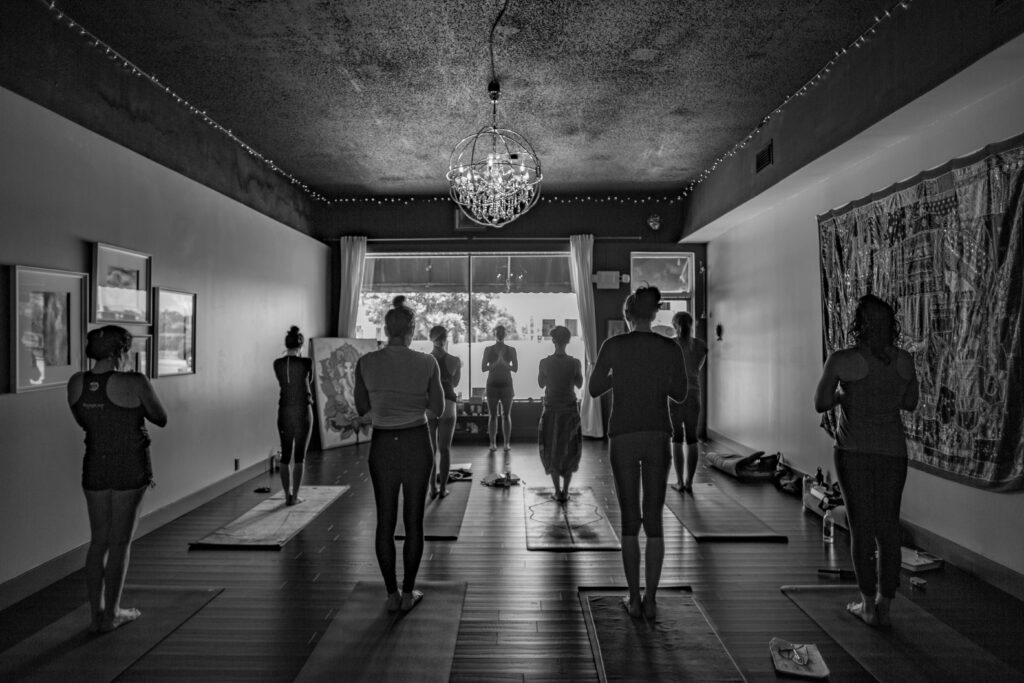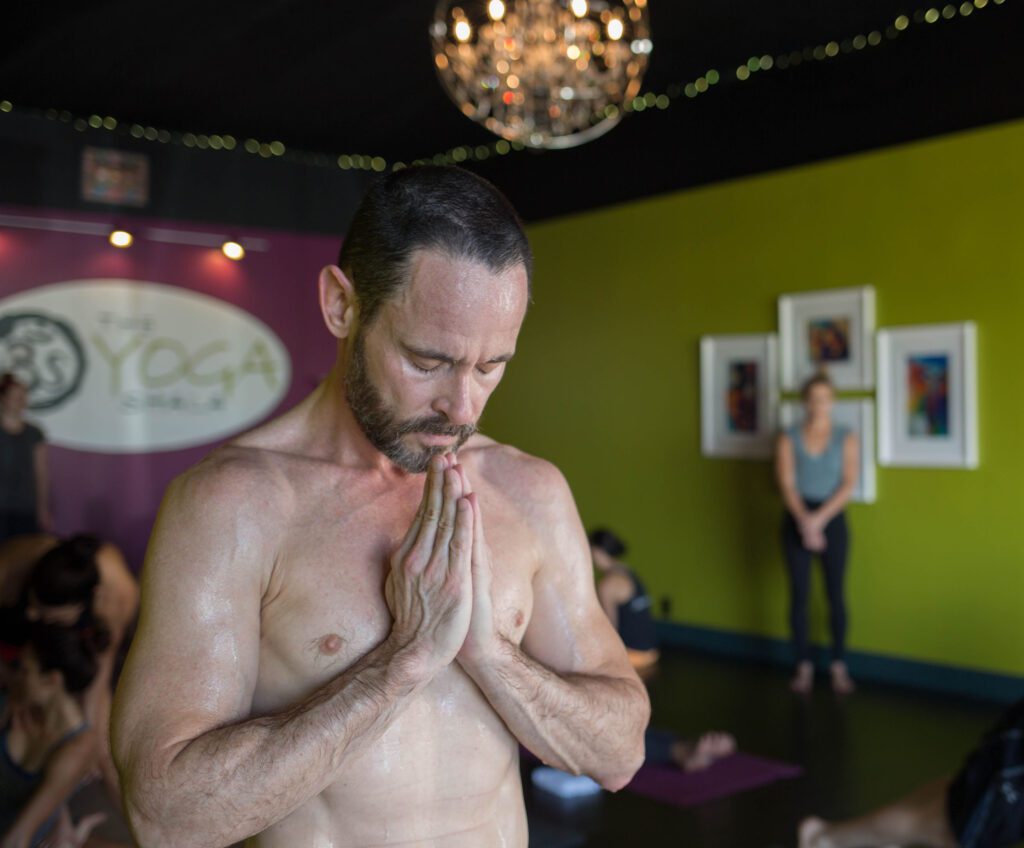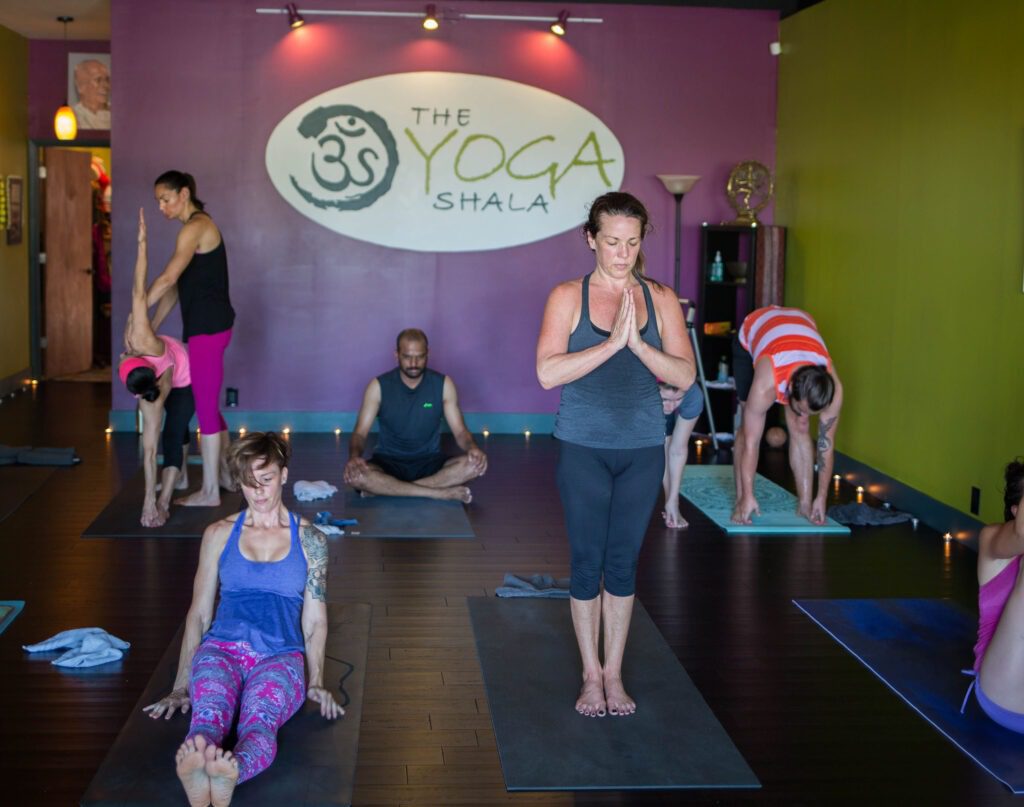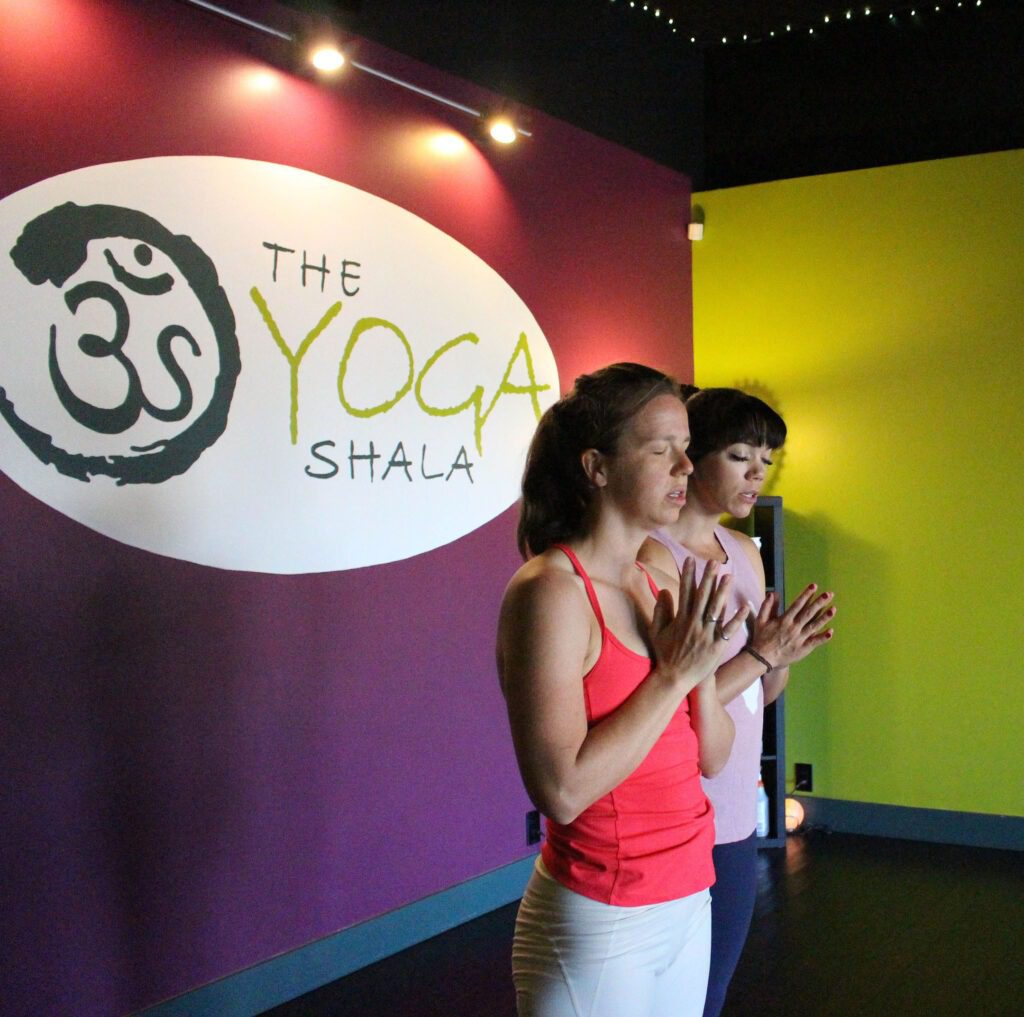Ashtanga Yoga is a traditional style of yoga that incorporates a set sequence of postures along with breath control and focus. The Ashtanga Yoga system also teaches students two sacred mantras.
Mantras are sacred syllables, words, or phrases often practiced as a form of meditation or chanting to enhance the practice.
Chanting mantras is part of a beautiful Bhakti (devotional) practice that offers so many incredible benefits to our mind and heart.
We chant to:
- Encourage mental focus to clear the mind move into deeper realms of consciousness
- Give thanks
- Develop Concentration, Humility, and Gratitude!
Vibrations of words in chants help to:
- Remove blockages that may come
- Bring harmony to the center
- Be with each word or sound as you chant
The Ashtanga Yoga Opening Mantra
This chant is a two part mantra:
1. A thanks and dedication to all the teachers who have kept this beautiful Ashtanga Yoga practice alive for thousands of years.
2. The second part of the mantra is a specific thanks to Patanjali. He codified the yoga shastras during the Kali Durga.
The purpose of the opening prayer is to thank all the teachers that have kept yoga alives for thousands of years. They have made it available for us to enjoy today. It also sets the intention for our practice to follow.
The “Ashtanga Opening Mantra” is chanted at the beginning of an Ashtanga Yoga practice. The Opening Mantra is also called the “Vande Gurunam” mantra. This is a Sanskrit verse that pays homage to the lineage of teachers who have passed down the wisdom and teachings of yoga. The mantra is chanted in a call-and-response style. The instructor leads and the students repeat after them.

The Opening Mantra starts as follows:
“Vande Gurunam Charanaravinde
Sandarshita Svatma Sukhava Bodhe
Nihshreyase Jangalikayamane
Samsara Halahala Mohashantyai”
The translation:
“I bow to the lotus feet of the gurus,
The awakening happiness of one’s own self revealed,
Beyond better, acting like the jungle physician,
Pacifying delusion, the poison of Samsara (the cycle of birth and death).”
Purpose of the Opening Mantra:
The Ashtanga Yoga opening mantra serves as an invocation. It sets the tone for the practice and acknowledges the lineage of yoga teachers who have contributed to the teachings of Ashtanga Yoga. Chanting the Opening Mantra can help to cultivate reverence, gratitude, and focus, creating a sense of connection to the wisdom and tradition of yoga.
Origins of the Ashtanga Opening Mantra:
Ashtanga Opening Mantra comes from two separate mantras that have been put together. The first half of the prayer comes from Yoga Taravali, by Adi Shankaracharya. According to Shankaracharya, a yoga teacher is to lead the disciple from darkness to light, from the poison of existence to the nectar of enlightenment.
Vande Gurunam Caranaravinde
Sandarsita Svatma Sukhava Bodhe
Nih Sreyase Jangalikayamane
Samsara Halahala Mohasantyai
The second half of the prayer comes from Patanjali Mamtram: ‘Prayer to Patanjali.’ This is performed each time Patanjali’s Yoga Sutras are recited and honors his contribution to the history of yoga.
Abahu Purusakaram
Sankhacakrasi Dharinam
Sahasra Sirasam Svetam
Pranamami Patanjali
The Opening Mantra is also known as the “Vande Gurunam” mantra. This prayer is chanted at the beginning of an Ashtanga Yoga practice to pay homage to the lineage of teachers who have passed down the wisdom and teachings of yoga. By acknowledging the gurus and expressing gratitude for their guidance, practitioners cultivate a sense of reverence and connection to the ancient tradition of yoga. The mantra serves as an invocation, setting the intention for the practice and inviting a state of openness and receptivity to the teachings of yoga.

Mantra as a tool for your practice:
Many students may also incorporate other mantras or chants during the practice. Others such as the closing mantra, or individual postures may have their own specific mantras associated with them. Mantras can be used as a tool to calm the mind, deepen concentration, and heighten spiritual awareness during the practice of Ashtanga Yoga.
It’s important to note that while mantras are a significant aspect of Ashtanga Yoga for many practitioners, they are not required. Furthermore, different instructors and students may have different preferences and approaches to incorporating mantras into their practice. It’s always best to follow the guidance of a qualified yoga teacher. Approach mantras with an open mind and respectful attitude towards their cultural and spiritual significance.
Ashtanga Yoga practitioners often recite the Opening and Closing Mantras as a way to honor the tradition and lineage of yoga. And they often recite this mantra to create a sacred and focused atmosphere for their practice.
Ashtanga Closing prayer:
This mantra is the Mangala Mantra, which comes from the Rig Veda. The essence of the mantra imparts that the practice we have just completed be of benefit to everyone in the world: “May all beings everywhere be happy and free”. By chanting this mantra at the end of your practice, you are basically saying, “I have completed my practice – let it benefit the world!”
Chanting Mangala Mantra at the end of practice is the perfect way to bring closure to your physical, mental, and spiritual session. Like the opening mantra, the repetition of this mantra brings harmony to your center and peace in your heart. It also instills a feeling of togetherness with the world, humility to your mind, and gratitude in your soul!
The Closing Mantra is also known as the “Samasthitihi” mantra. This prayer is chanted at the end of an Ashtanga Yoga practice to bring the practice to a complete and harmonious close. The mantra translates as follows:
“May all beings be happy, may all beings be healthy, may all beings be safe, may all beings live with ease.”
By reciting this mantra, practitioners express their heartfelt wishes for the well-being of all beings, including themselves, their loved ones, and all living beings in the world. The Closing Mantra serves as a reminder of the interconnectedness of all beings. And the importance of cultivating compassion and goodwill towards others.
Chanting for peace of mind:
Reciting the Opening and Closing Mantras in Ashtanga Yoga is not only a ritualistic practice, but also a way to create a meditative and focused state of mind. The repetition of the sacred syllables and words in the mantras can help to calm the mind. They can also deepen concentration, and enhance spiritual awareness. Chanting the mantras also helps to synchronize the breath and movements in the practice, creating a sense of rhythm and flow.

It’s important to approach mantras with respect, understanding their cultural and spiritual significance. It’s also helpful to follow the guidance of a qualified yoga teacher in incorporating them into your practice. Ultimately, the recitation of the Opening and Closing Mantras in Ashtanga Yoga can serve as a personal expression of reverence, gratitude, and mindfulness, enhancing the overall experience of the practice.
The Opening and Closing Mantras used in Ashtanga Yoga have a rich history that can be traced back to the ancient yogic traditions of India. These mantras have been passed down through generations of yoga practitioners and teachers, and are considered to be an integral part of the Ashtanga Yoga practice.
Origns of the Opening and Closing Mantra:
The exact origins and authorship of the Opening and Closing Mantras are not well-documented. They have been handed down orally over the centuries. However, it is believed that these mantras were composed in Sanskrit, which is considered to be the classical language of ancient India, and have been recited in various forms of yoga for centuries.
Opening Chant:
The Opening Mantra, “Vande Gurunam Charanaravinde,” is often attributed to Sage Veda Vyasa. He is considered to be a revered figure in the Hindu tradition. Sage Veda Vyasa is also believed to have compiled the ancient scriptures known as the Vedas. This mantra is also sometimes associated with the teacher-student lineage of T. Krishnamacharya. He is considered to be one of the modern fathers of Hatha Yoga and is known to have influenced the development of Ashtanga Yoga.
Closing Chant:
The authorship of the Closing Mantra is not well-documented, but it is widely used in various forms of yoga as a way to express goodwill and positive intentions towards oneself and others.
It’s important to note that while the specific history and origins of the Opening and Closing Mantras may not be fully known, these mantras have been revered and passed down through generations of yogis. This is a way to honor the lineage of yoga teachers, invoke blessings, and cultivate mindfulness and compassion. They are considered to be sacred and are used in Ashtanga Yoga as a way to create a focused, reverential, and meditative atmosphere for the practice.
Reciting mantras, whether in the context of yoga, meditation, or other spiritual practices, is believed to offer a wide range of benefits for the mind, body, and spirit.

Potential benefits of reciting mantras:
Calming the mind:
The repetition of mantras can help to calm the mind and slow down the mental chatter. Mantras act as a focal point, helping to anchor the mind in the present moment. That is turn helps you quiet the stream of thoughts, which can promote a sense of peace and tranquility.
Enhancing concentration:
The rhythmic repetition of mantras can help to improve concentration and focus. By directing the mind to a specific sound or phrase, mantras can support the development of one-pointedness of mind. This in turn can lead to increased mental clarity and mindfulness.
Reducing stress and anxiety:
Reciting mantras is believed to activate the relaxation response in the body, helping to reduce stress and anxiety. The calming effect of mantras on the nervous system can help to lower cortisol levels, ease tension, and promote a state of deep relaxation.
Cultivating positive qualities:
Many mantras are associated with specific qualities or intentions, such as compassion, love, or gratitude. By repeatedly reciting mantras that embody positive qualities, practitioners can help to cultivate those qualities within themselves. Over time this can lead to personal growth, self-awareness, and a positive mindset.
Connecting with the divine:
Mantras are often considered sacred and are used as a means of connecting with the divine or higher consciousness. The repetition of mantras is believed to help align the individual with higher spiritual energies, promoting a sense of reverence, devotion, and connection to something greater than oneself.
Energizing the body:
Some mantras are believed to have specific vibrational qualities that can stimulate and balance the energy centers in the body, known as chakras. The chanting of mantras can help to activate and harmonize these energy centers, promoting physical well-being and vitality.
Enhancing self-expression:
Mantras can also be used as a form of self-expression, allowing individuals to channel their emotions, creativity, and inner voice. Reciting mantras can offer a means of self-affirmation, self-reflection, and self-empowerment.
Please Note:
It’s important to note that the benefits of reciting mantras may vary depending on individual beliefs, intentions, and practices. Mantras are a personal and subjective experience. And it’s essential to approach them with sincerity, reverence, and respect for their cultural and spiritual significance. It’s recommended to learn mantras from qualified teachers and practitioners, and to integrate them into one’s practice with mindfulness and discernment.
Click here to view our YouTube video on Mantras and the Ashtanga Yoga Opening and Closing Mantras
Keep Learning
❤️ If you would like to learn yoga with me online, you can do so through my YouTube channel: https://www.youtube.com/@yogawithkrista
Our mission is to help as many people as possible find wholeness in their lives through totally free, high quality yoga videos. We welcome all levels, all people, all bodies, all genders, absolutely everyone! SUBSCRIBE to the channel and join wholeness (Olotita) movement! ❤️
Yoga Tutorial Playlist:
❤️ Yoga is truly accessible to everyone! The hardest part is showing up. Tap here to access the Yoga Tutorial Playlist on Youtube.
About Krista:
I am a level II authorized Ashtanga Yoga teacher and I am passionate about sharing these teachings with all who wish to learn.
If you want to join me in person I teach daily classes at The Yoga Shala in Winter Park, Florida. Additionally, I offer virtual sessions in Yoga, Meditation, Breath-work, Nutrition, Life Coaching and Mentorship. Check out www.theyogashala.org for more details.
If you do not live in Central Florida and want to find an authorized teacher in your area, check out my teacher, Sharath Jois’ website, for a list of all teachers authorized and certified by his yoga centre in India.

Stay in touch:
❤️Be sure to https://olotita.com/yoga-classes-in-winter-park-florida/newsletter/ to stay on top of local events and classes, Nysa products sales, new offerings, new products and more! ❤️
❤️We appreciate all your support. If you’d like to donate to our channel: Paypal
[email protected]. Please put “donation” in your message. Thank you.
❤️SHOP MERCHANDISE: Nysa Products
❤️CLASSES & PRIVATE INSTRUCTION: If you would like to book your spot for my upcoming group engagements or work privately with me on an individual basis please visit: www.theyogashala.org
❤️SOCIAL MEDIA: You can catch other content by following me on:
Instagram: @kristashirleyyoga
Instagram: @theyogashala_
Facebook: @theyogashala
Facebook: @KristaShirleyYoga
TikTok: @kristashirleyyoga
Twitter: @kristayogini
❤️For other inquires please contact: [email protected]
❤️Thank you for liking, subscribing, and sharing our videos!❤️
❤️ Namaste ❤️







